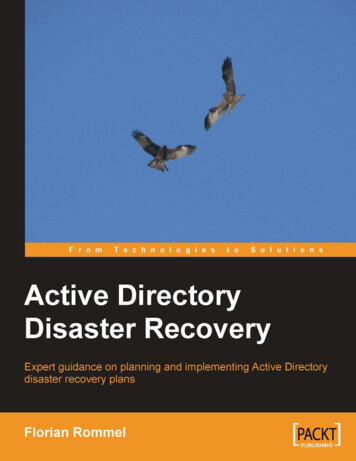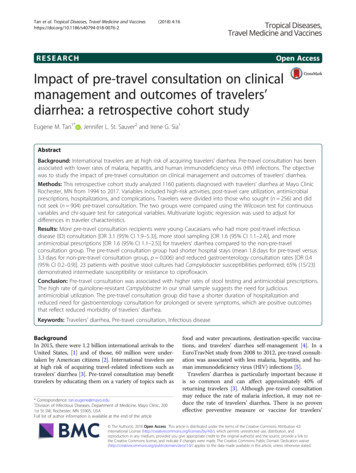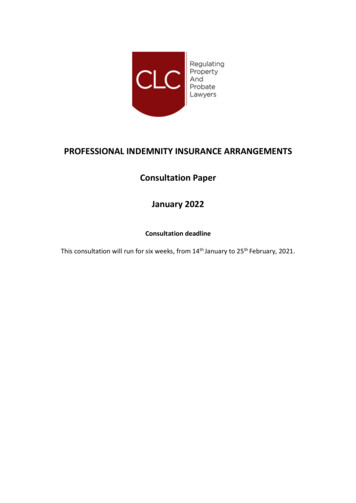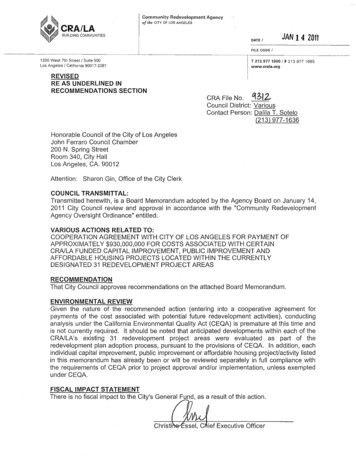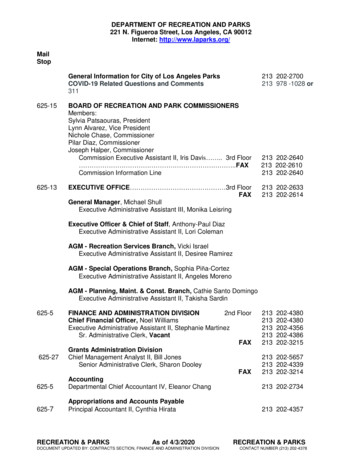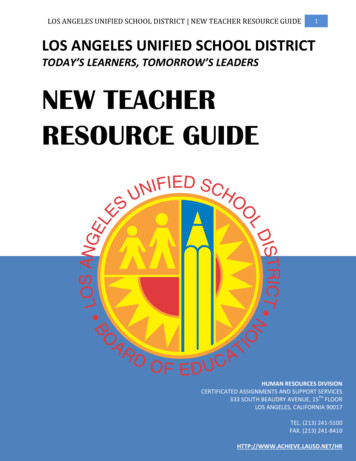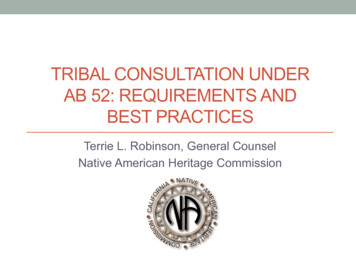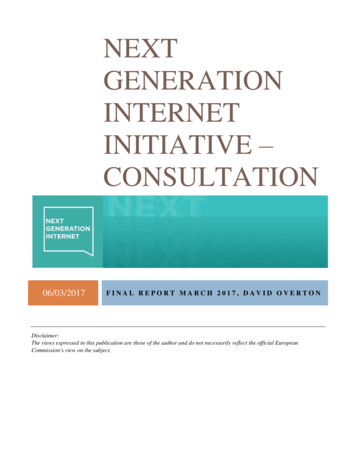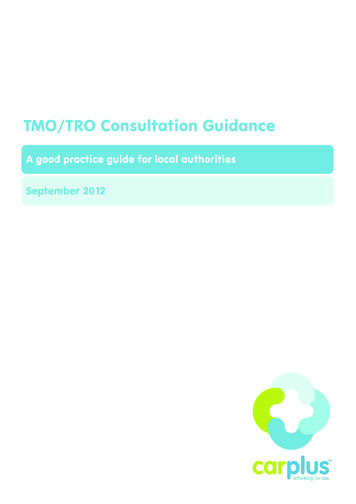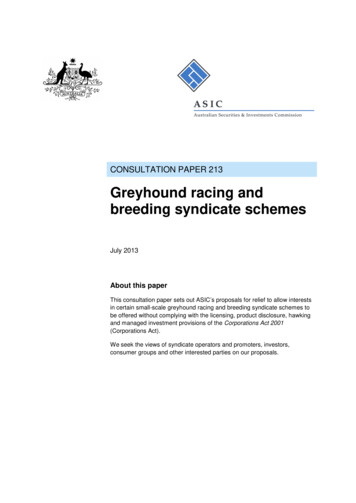
Transcription
CONSULTATION PAPER 213Greyhound racing andbreeding syndicate schemesJuly 2013About this paperThis consultation paper sets out ASIC’s proposals for relief to allow interestsin certain small-scale greyhound racing and breeding syndicate schemes tobe offered without complying with the licensing, product disclosure, hawkingand managed investment provisions of the Corporations Act 2001(Corporations Act).We seek the views of syndicate operators and promoters, investors,consumer groups and other interested parties on our proposals.
CONSULTATION PAPER 213: Greyhound racing and breeding syndicate schemesAbout ASIC regulatory documentsIn administering legislation ASIC issues the following types of regulatorydocuments.Consultation papers: seek feedback from stakeholders on matters ASICis considering, such as proposed relief or proposed regulatory guidance.Regulatory guides: give guidance to regulated entities by: explaining when and how ASIC will exercise specific powers underlegislation (primarily the Corporations Act) explaining how ASIC interprets the law describing the principles underlying ASIC’s approach giving practical guidance (e.g. describing the steps of a process suchas applying for a licence or giving practical examples of howregulated entities may decide to meet their obligations).Information sheets: provide concise guidance on a specific process orcompliance issue or an overview of detailed guidance.Reports: describe ASIC compliance or relief activity or the results of aresearch project.Document historyThis paper was issued on 23 July 2013 and is based on the CorporationsAct as at the date of issue.DisclaimerThe proposals, explanations and examples in this paper do not constitutelegal advice. They are also at a preliminary stage only. Our conclusions andviews may change as a result of the comments we receive or as othercircumstances change. Australian Securities and Investments Commission July 2013Page 2
CONSULTATION PAPER 213: Greyhound racing and breeding syndicate schemesContentsThe consultation process .4ABackground to the proposals .6Proposed relief for greyhound racing and breeding syndicate schemes .6Current relief for horse racing and breeding schemes .7Greyhound racing and breeding in Australia .7Our proposals for relief .8BOur proposals .11Relief for small-scale schemes .11Co-regulation with controlling bodies .13Recognition of controlling bodies .14Rules of controlling bodies.15Disclosure to offerees and members .16Dispute resolution .18Public offer advertising .19CRegulatory and financial impact .21Key terms .22List of proposals and questions .24Appendix 1: Comparison of proposed racing rules with currentrequirements .27Appendix 2: Comparison of proposed disclosure document withPDS requirements .31 Australian Securities and Investments Commission July 2013Page 3
CONSULTATION PAPER 213: Greyhound racing and breeding syndicate schemesThe consultation processYou are invited to comment on the proposals in this paper, which are only anindication of the approach we may take and are not our final policy.As well as responding to the specific proposals and questions, we also ask youto describe any alternative approaches you think would achieve our objectives.We are keen to fully understand and assess the financial and other impactsof our proposals and any alternative approaches. Therefore, we ask you tocomment on: the likely compliance costs; the likely effect on competition; and other impacts, costs and benefits.Where possible, we are seeking both quantitative and qualitative information.We are also keen to hear from you on any other issues you consider important.Your comments will help us develop our policy on the regulation of greyhoundracing and breeding syndicate schemes. In particular, any information aboutcompliance costs, impacts on competition and other impacts, costs and benefitswill be taken into account if we prepare a Regulation Impact Statement: seeSection C, ‘Regulatory and financial impact’.Making a submissionWe will not treat your submission as confidential unless you specificallyrequest that we treat the whole or part of it (such as any financialinformation) as confidential.Comments should be sent by 27 August 2013 to:Violet WongSenior LawyerInvestment Managers and SuperannuationAustralian Securities and Investments CommissionLevel 5, 100 Market StreetSydney NSW 2000facsimile: 02 9911 2414email: greyhoundschemes@asic.gov.au Australian Securities and Investments Commission July 2013Page 4
CONSULTATION PAPER 213: Greyhound racing and breeding syndicate schemesWhat will happen next?Stage 123 July 2013ASIC consultation paper releasedStage 227 August 2013Comments due on the consultation paperNovember 2013Signing memoranda of understanding withcontrolling bodiesEarly 2014Relief instrument and related documentsreleasedStage 3 Australian Securities and Investments Commission July 2013Page 5
CONSULTATION PAPER 213: Greyhound racing and breeding syndicate schemesABackground to the proposalsKey pointsASIC has been asked to consider granting class order relief from certainprovisions of the Corporations Act to greyhound racing and breedingsyndicates that are managed investment schemes under Ch 5C.We have previously granted relief to horse racing schemes relying on a coregulation arrangement between ASIC and horse racing industryregulators.We consider that a co-regulation arrangement may also be usefully establishedfor small-scale greyhound racing and breeding syndicate schemes, so that reliefcould be provided for these schemes, subject to an appropriate co-regulatoryframework and certain conditions.Proposed relief for greyhound racing and breeding syndicate schemes1Greyhound racing and breeding syndicate schemes involve people contributingmoney or the use of a greyhound they own in common with others for the rightto benefits from a scheme. Under the scheme, the greyhound is maintained andused to produce financial benefits from prize money won by racing thegreyhound, or from the sale of the greyhound or its offspring. In some cases,the contributors do not have day-to-day control over the use of the greyhoundas this function is performed by a subset of the contributors or a syndicatemanager. Such arrangements may be managed investment schemes underCh 5C of the Corporations Act 2001 (Corporations Act).2Greyhound racing and breeding syndicates that are managed investmentschemes are regulated by certain provisions of the Corporations Act. Interestsin these schemes are generally financial products unless a syndicate has no morethan 20 members and is promoted by a person who (including their associates) isnot carrying on a business of promoting managed investment schemes.3Because the interests are financial products, the syndicate operator willgenerally be required to hold an Australian financial services (AFS) licenceauthorising it to carry on a business of issuing interests in the scheme. Ifinterests in the scheme are issued to retail clients, a Product DisclosureStatement (PDS) may need to be given. In addition, because the schememeets the requirements for a managed investment scheme under Ch 5C ofthe Corporations Act, the scheme operator must register the scheme andcomply with the managed investment provisions.4We have been asked to consider granting relief to greyhound racing andbreeding syndicate schemes from these provisions of the Corporations Act. Australian Securities and Investments Commission July 2013Page 6
CONSULTATION PAPER 213: Greyhound racing and breeding syndicate schemesCurrent relief for horse racing and breeding schemes5We have previously granted class order relief to horse racing and breedingschemes from certain requirements of the Corporations Act. In particular,ASIC has granted class order relief to horse racing schemes from themanaged investment scheme registration requirement under co-regulationarrangements. These arrangements are set out in Regulatory Guide 91 Horseracing and breeding schemes (RG 91).6Our relief recognises that co-regulation arrangements are a more appropriateform of regulation for small-scale horse racing schemes.7Horse racing schemes with no more than 20 members and subscription fundsnot exceeding 250,000 are eligible for relief under the co-regulationarrangements. Under these arrangements, certain horse racing clubs areapproved as lead regulators by ASIC.8While ASIC performs regulatory functions through our licensing role andby overseeing the lead regulators’ activities, these lead regulators assumeregulatory functions by:(a)maintaining a register of all promoters of horse racing schemes to whichthe co-regulation arrangements apply. This includes giving ASIC thename of any promoter who has been removed from the register becauseof a failure by the promoter to comply with the lead regulators’ rules onthe promotion and operation of horse racing schemes;(b)overseeing new schemes by approving the agreements that establish thescheme and monitoring the advertising of the scheme, as well asensuring that a promoter’s PDS contains the required information;(c)overseeing ongoing schemes by ensuring that the promoters andmanagers of the schemes lodge their reports and accounts, dealing withcomplaints and referring cases to ASIC that may involve breaches ofthe Corporations Act or AFS licence conditions; and(d)implementing adequate surveillance, enforcement and disciplinaryprocedures, including in relation to unlawful offerings by promoterswho are not regulated by the lead regulator.Greyhound racing and breeding in Australia9There are currently around 71 greyhound racing clubs in Australia. In 2011,about 38,380 races were held, attended by close to half a million people.Stakeholder money involved was approximately 83 million.10The industry of greyhound racing (and breeding) in Australia is subject to agovernance structure similar to that of horse racing and breeding. Inparticular, a controlling body is set up in each state or territory by enabling Australian Securities and Investments Commission July 2013Page 7
CONSULTATION PAPER 213: Greyhound racing and breeding syndicate schemesActs, which empower these bodies to make rules for greyhound racing—including, for example:(a)licensing of the ownership and/or training of greyhounds;(b)registration of greyhound racing clubs;(c)rules for race meetings;(d)welfare of the racing greyhounds;(e)handling of complaints related to race meetings; and(f)imposition of penalties and sanctions for breaching the rules.11Consistency and uniformity of the rules and regulations between differentjurisdictions (i.e. states and territories) are promoted through membership ofthe national industry representative, Greyhounds Australasia. GreyhoundsAustralasia is a not-for-profit organisation whose charter is to ‘support thejurisdictions via encouragement of a holistic approach to the Australasiangreyhound racing industry and creating uniformity with the brand’. For acopy of the draft rules currently proposed by Greyhounds Australasia in thecontext of the proposals in this paper, go to www.galtd.org.au.12The board of directors of Greyhounds Australasia is made up of a director fromeach of the jurisdictional controlling bodies. Greyhounds Australasia administers aset of rules that apply to its members—the Greyhounds Australasia Rules—whichare subject to review every 12 months. New rules are adopted (including ruleamendments) through a process that requires a minimum of 66% of the votes castby Greyhounds Australasia’s board of directors.13Greyhounds Australasia has submitted to ASIC that its members generallyformulate their jurisdictional rules based on the Greyhounds AustralasiaRules, although members are empowered to make other rules andregulations.Our proposals for relief14We consider that, subject to conditions, class order relief from certain provisionsof the Corporations Act may be appropriate for small-scale greyhound racingand breeding syndicate schemes: see Section B. Our proposals take into account:(a)our general policy on relief;(b)the relatively small scale of operation and low financial exposure forparticipants in these schemes;(c)the mostly non-investment character of these schemes; and(d)the existence of adequate alternative regulation in the role of thecontrolling bodies. Australian Securities and Investments Commission July 2013Page 8
CONSULTATION PAPER 213: Greyhound racing and breeding syndicate schemesOur general policy on relief15In Regulatory Guide 51 Applications for relief (RG 51), we state that whenconsidering new policy relief such as the relief we are currently proposing, wewill weigh the commercial benefit against any net regulatory benefit or detrimentthat would flow from granting the relief under the proposed conditions: seeRG 51.44.16We will generally grant relief where:(a)we consider that there is a net regulatory benefit; or(b)the regulatory detriment is minimal and is clearly outweighed by theresulting commercial benefit.17In addition to the overarching principles for relief in RG 51, we have stated inother regulatory guides that we will consider relief from the requirements toregister a managed investment scheme under Ch 5C, to hold an AFS licence andto provide disclosure under Pt 7.9 to address atypical or unforeseencircumstances and unintended consequences of the relevant laws.18Specifically, we will consider giving relief from the scheme registrationrequirements in Ch 5C if:(a)strict compliance with the law would be impossible ordisproportionately burdensome;(b)people acquiring or holding interests in the scheme would still have theprotection that they were intended by Parliament to have; and(c)there would be commercial benefit for the parties to the scheme: seeRegulatory Guide 136 Managed investments: Discretionary powers andclosely related schemes (RG 136).19In relation to licensing and disclosure relief, we will only exercise ourpowers to give relief in a way that is consistent with Parliamentary intention:see Regulatory Guide 167 Licensing: Discretionary powers (RG 167) andRegulatory Guide 169 Disclosure: Discretionary powers (RG 169).20One consideration for licensing relief is whether the predominant purpose of theproduct is a financial product purpose. We will also consider giving relief fromthe licensing and disclosure requirements on the basis of adequate alternativeregulation.Small scale21Compared to the horse racing and breeding industry, the greyhound racing andbreeding industry is generally smaller in terms of public participation and theamounts of money involved. We have been advised that greyhound racing andbreeding syndicates are generally of a smaller scale, with the typical cost of agreyhound pup ranging between 1,500 and 3,000. Therefore, participants ofthese schemes are exposed to a relatively lower financial risk. Conversely, Australian Securities and Investments Commission July 2013Page 9
CONSULTATION PAPER 213: Greyhound racing and breeding syndicate schemesrelative to funds invested, the costs of compliance with the Corporations Actmay be more burdensome than for most other managed investment schemes.22For details of what we propose to consider as a small-scale scheme for thepurposes of our relief, see proposal B1.Non-investment character23Given the inherent uncertainties in greyhound racing and breeding, it would beapparent to participants in these schemes that obtaining any financial rewardfrom participation would be speculative. The predominant purpose of agreyhound racing and breeding syndicate scheme, or an investment in sucha scheme, is generally not for a financial product purpose, unlike an investmentin a traditional managed investment scheme that invests, for example, inproperty, mortgages or financial assets. This is a consideration supporting reliefas set out in RG 167.11A–RG 167.11B. We believe that for many participantsthe intrinsic value of owning a racing greyhound and being active in the sportwould be an important consideration, rather than primarily the expectationsabout risk and returns that are relevant to investments generally.24We acknowledge that the nature of the operation of greyhound racing andbreeding syndicate schemes is also likely to be different from a typicalmanaged investment scheme. The essential skills and expertise required tooperate these schemes, as well as the risks involved, are significantly differentand suggest that specialised regulation and supervision may be appropriate.25For details of our proposals for disclosure, dispute resolution mechanismsand public offer advertising under our relief, see proposals B5–B7.Adequate alternative regulation26We recognise that the state and territory controlling bodies that governgreyhound racing and breeding syndicate schemes may be well placed toperform a regulatory role for these schemes, given that they are close to theindustry, have knowledge of the industry and are able to focus resources onthe regulation of the schemes. These factors potentially allow greatereffectiveness and efficiency in carrying out a co-regulatory function as partof their roles, compared to ASIC having the sole regulatory role.27For details of the proposed co-regulation arrangement under our relief, seeproposals B2–B3. Australian Securities and Investments Commission July 2013Page 10
CONSULTATION PAPER 213: Greyhound racing and breeding syndicate schemesBOur proposalsKey pointsWe propose to give class order relief to small-scale greyhound racing andbreeding syndicate schemes from the requirements to: hold an Australian financial services (AFS) licence (see proposal B1); register a scheme under Ch 5C of the Corporations Act (so that syndicateoperators would not be subject to the managed investment provisions) (seeproposal B1); give disclosure in a Product Disclosure Statement (PDS) under Pt 7.9 (seeproposal B1); and comply with the prohibition on unsolicited meetings, where the meetingis at a greyhound racing track (see proposal B4).We propose that under this relief: regulation would be shared between ASIC and jurisdictional controllingbodies (see proposal B2); the jurisdictional controlling bodies would administer rules that broadlysatisfy the criteria for adequate alternative regulation (see proposal B4); although the disclosure requirements under Pt 7.9 would not apply, syndicateoperators would be required to give offerees a disclosure document approvedby the relevant controlling body, and provide members with regular statementsthat are broadly based on a periodic statement under s1017D (seeproposal B5); and syndicate operators would be required to maintain internal and externaldispute resolution mechanisms (see proposal B6).We propose that, where an offer of interests in a greyhound racing or breedingsyndicate scheme is publicly advertised, relief would be available only if thisadvertising meets certain restrictions: see proposal B7.Relief for small-scale schemesProposalB1We propose to give class order relief from the relevant managedinvestment, licensing and product disclosure provisions in Ch 5C andPts 7.6 and 7.9 of the Corporations Act, and limited relief from thehawking provisions in s992AA, to small-scale greyhound racing andbreeding syndicate schemes involving a specified greyhound orgreyhounds that are to be owned by the participants. We wouldconsider a scheme to be small scale if:(a)the syndicate operator has raised from members (on becoming amember or subsequently) not more than 2 million in total under all Australian Securities and Investments Commission July 2013Page 11
CONSULTATION PAPER 213: Greyhound racing and breeding syndicate schemesgreyhound racing or breeding syndicate schemes to which therelief applies that the operator operates in any 12-month period;and(b)each scheme:(i)has 20 or fewer members calculated on the same basis as ins601ED(4) of the Corporations Act;(ii)does not involve raising from members (on becoming amember or subsequently) more than 150,000 in total; and(iii)is governed by an agreement that includes these restrictions.Your feedbackB1Q1Do you agree that relief from the relevant managedinvestment, licensing, product disclosure and hawkingprovisions of the Corporations Act should be provided tosmall-scale greyhound racing and breeding syndicateschemes? If not, why not?B1Q2Do you agree with what we consider to be a small-scalescheme for the purposes of determining whether this reliefshould apply?B1Q3What would be the cost for a typical greyhound racing orbreeding syndicate scheme of complying with each of therelevant (managed investment, licensing and productdisclosure) provisions?B1Q4What would be the benefits to participants of the schemecomplying with each of these provisions?Rationale28Small-scale greyhound racing and breeding syndicate schemes involve a smallamount of money in total and are part of a business that is not large in scale.In light of this low financial exposure, the costs of complying with the relevantrequirements under the Corporations Act (e.g. meeting financial requirements,maintaining a compliance plan, carrying out the required audits and producingPDSs) may be burdensome. We consider that it may be unreasonable to imposethis burden if these schemes are subject to adequate alternative regulation by thejurisdictional controlling bodies.29We propose to set the monetary cap at 2 million per operator per year, aswell as 150,000 per scheme, because we consider some compliance costsare not specific to a scheme but apply to the operator, such as the costs ofobtaining and maintaining an AFS licence. The cap provides a measure ofpotential benefit against which costs can be considered. If a greyhoundracing and breeding syndicate scheme is larger in scale, the costs of anAFS licence may not be disproportionate. The proposed cap is alsocomparable to s1012E, which uses raising 2 million as one of the criteriafor determining the appropriateness of an exemption from the PDSrequirements. Australian Securities and Investments Commission July 2013Page 12
CONSULTATION PAPER 213: Greyhound racing and breeding syndicate schemes30The limit of 20 members per scheme reflects the threshold in s601ED(1)(a)and 1012E of the Corporations Act.Co-regulation with controlling bodiesProposalB2We propose that our relief would be based on a co-regulationarrangement with jurisdictional controlling bodies so that relief would berestricted to schemes that are registered with, and submit to theregulation of, a controlling body recognised by ASIC: see Table 1 andproposal B3.Your feedbackB2Q1Table 1:Do you consider there to be any practical issues with theproposed co-regulation arrangement? If so, what are they?Proposed co-regulation arrangementAreaDescriptionRegistration ofoperators and schemesThe controlling body would need to have a process inplace for registering each operator and scheme.Disclosure documentsThe controlling body would need to have a process inplace for approving the content of and lodgingdisclosure documents from scheme operators thatwould replace PDSs: see proposal B5.Reporting of breachesThe controlling body would need to sign amemorandum of understanding with ASIC and agree toreport to ASIC on a regular basis any significantbreaches of its rules or regulations (and the resolutionor the sanction imposed as a result) by the syndicateoperator of any schemes registered with the controllingbody, or any other greyhound racing and breedingsyndicate schemes of which it is aware.In addition, the controlling body would need to agree, inthat event, to take appropriate action within its power.Exclusion of operatorsASIC would have power to exclude a scheme operatorfrom the class order relief if appropriate.Rationale31A co-regulation arrangement would take advantage of the influential positioncontrolling bodies have in the regulation of greyhound racing and breedingsyndicate schemes. The controlling bodies would have the primary functionof regulating these schemes, subject to supervision by ASIC. Australian Securities and Investments Commission July 2013Page 13
CONSULTATION PAPER 213: Greyhound racing and breeding syndicate schemes32If a syndicate operator does not comply with the requirements for relying on theclass order relief, it must comply with the Corporations Act, including thelicensing, registration and disclosure requirements. Under the co-regulationarrangement, we would rely on the expertise and diligence of the relevantcontrolling bodies to ensure that greyhound racing syndicates (over which theycan exert influence) comply with the requirements for exemption, or theprovisions of the Corporations Act that apply if the exemption does not.33However, we retain the power to take regulatory action, such as excluding asyndicate operator from class order relief if appropriate (e.g. where an operatorbreaches the rules of the controlling body). Nothing in the proposed reliefremoves ASIC’s power to take action, including criminal proceedings whereapplicable, against any contravention of the Corporations Act.Recognition of controlling bodiesProposalB3We propose to recognise a controlling body for the purposes of ourrelief only if it:(a)is a member of Greyhounds Australasia;(b)has rules that constitute adequate alternative regulation (seeproposal B4);(c)has satisfied ASIC that it has the capacity and adequate policiesand procedures to administer its rules effectively;(d)has signed a memorandum of understanding with ASIC; and(e)has not been notified by ASIC that it is not a recognised controllingbody for the purposes of the proposed relief.Recognition of the controlling body for the purposes of our relief would bein force only while the body agrees to and demonstrates that it can meetour expectations of a controlling body under the relief: see Table 1 underproposal B2.Your feedbackB3Q1Do you agree with the criteria for recognition of acontrolling body for the purposes of our relief?B3Q2If not, what criteria do you propose for this purpose?Rationale34Controlling bodies must have consistent rules to ensure that syndicateoperators are subject to consistent regulation, regardless of the state orterritory in which they are based. Membership of Greyhounds Australasiawould help to ensure consistency in the rules across different jurisdictionalcontrolling bodies. Australian Securities and Investments Commission July 2013Page 14
CONSULTATION PAPER 213: Greyhound racing and breeding syndicate schemes35ASIC and Greyhounds Australasia envisage that, if relief is granted, newrules relevant to the relief would be incorporated into the GreyhoundsAustralasia Rules. The jurisdictional controlling bodies would then adoptthese new rules into their own rules and enforce these rules undermemoranda of understanding between them and ASIC. These rules shouldconstitute adequate alternative regulation for the purposes of our relief.36Given the regulatory role of a controlling body under a co-regulationarrangement, controlling bodies would need to have the capacity as well asappropriate policies and procedures in place to give effect to these rules.37We will make the terms of the memoranda of understanding publiclyavailable. We consider that such information should also be disclosed on thewebsite of the relevant disclosing entity. A jurisdictional controlling bodymay be notified by ASIC that it has ceased to be a recognised controllingbody for the purposes of the proposed relief in certain circumstances,including if the controlling body fails to adopt and/or enforce the relevantrules.Rules of controlling bodiesProposalB4We propose that our relief would be based on controlling bodies havingrules that broadly satisfy the criteria in RG 167.11C and RG 169.10C, aswell as the key elements of s601FC of the Corporations Act, except for:(a)the limitations on hawking of products by service providers to retailclients (see RG 169.10C(f)); and(b)the requirement for adequate alternative regulation to includerequirements for compliance and risk management practices byservice providers (see RG 167.11C(c)).Your feedbackB4Q1Do you agree with the proposed requirements for therelevant rules?B4Q2Are there other aspects that these rules should address? Ifso, what are they?B4Q3Do you agree that rules should not be required to addresshawking or compliance and risk management practicesspecifically? If not, why not?Rationale38Our strategic objectives of consumer protection would be achievable under aco-regulation arrangement only if a recognised controlling body’s role as aco-regulator is supported by adequate rules and regulations. Australian Securities and Investments Commission July 2013Page 15
CONSULTATION PAPER 213: Greyhound racing and breeding syndicate schemes39We consider that these
Australasia is a not-for-profit organisation whose charter is to 'support the jurisdictions via encouragement of a holistic approach to the Australasian greyhound racing industry and creating uniformity with the brand'. For a copy of the draft rules currently proposed by Greyhounds Australasia in the
